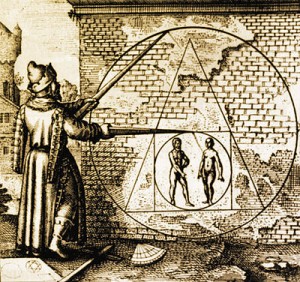 Squaring the Circle is a geometry problem and a spiritual puzzle. It dates back at least 4,000 years. All of the great cultures that expressed advanced mathematics and philosophy approached this problem and had a mythology to give it meaning. On one hand, it is a practical, geometric exercise exploring approximations of PI and Phi. On the other hand, it is a philosophical puzzle to combine opposites and find the perfect balance. Can a human find their way through the maze of different extremes that we encounter in our mortal experience? We must navigate between light and darkness, health and sickness, pleasure and pain, life and death, good and evil. The greatest minds in history have expressed pleasure and enlightenment from this geometry exercise. A famous Greek philosopher included a statement in his work “On Exile” referring to one of his fellow countrymen who worked the squaring problem:
Squaring the Circle is a geometry problem and a spiritual puzzle. It dates back at least 4,000 years. All of the great cultures that expressed advanced mathematics and philosophy approached this problem and had a mythology to give it meaning. On one hand, it is a practical, geometric exercise exploring approximations of PI and Phi. On the other hand, it is a philosophical puzzle to combine opposites and find the perfect balance. Can a human find their way through the maze of different extremes that we encounter in our mortal experience? We must navigate between light and darkness, health and sickness, pleasure and pain, life and death, good and evil. The greatest minds in history have expressed pleasure and enlightenment from this geometry exercise. A famous Greek philosopher included a statement in his work “On Exile” referring to one of his fellow countrymen who worked the squaring problem:
“There is no place that can take away the happiness of a man, nor yet his virtue or wisdom. Anaxagoras, indeed, wrote on the squaring of the circle while in prison.”
-Plutarch
The basic puzzle is this: Using only a square, a compass, a straight edge and a writing stick, create a square with the same circumference or area as a circle. It has to be done in a finite number of steps. You can not measure it numerically (with a ruler). It all has to be done through proportion and true principles using four unmarked tools.
It’s a geometry puzzle with meanings, here are some basic interpretations.
 Right-Angled Square: This represents logic and law. It is associated with the head and mind. It is left thinking.
Right-Angled Square: This represents logic and law. It is associated with the head and mind. It is left thinking.
..
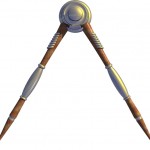 Compass: Used for making circles. This represents feeling and intuition, the emotional mind. It is associated with the heart. It is right thinking.
Compass: Used for making circles. This represents feeling and intuition, the emotional mind. It is associated with the heart. It is right thinking.
.
..
 Writing Stick: This represents our desire, our appetites, what we hunger for, the energy and will that drives action (like drawing and working a puzzle). It could also be called faith in its verb form. It is associated with the belly, the source of hunger and desire.
Writing Stick: This represents our desire, our appetites, what we hunger for, the energy and will that drives action (like drawing and working a puzzle). It could also be called faith in its verb form. It is associated with the belly, the source of hunger and desire.
.
..
Straight Edge: This represents precision, exactness and a division between opposites (good/evil, dark/light, etc.). It represents a decision, a commitment and an action that separates thinking from doing. The knee divides the upper leg from the lower leg, and the leg is symbolic of walking a path towards a destination. A straight line represents boundaries..
..
.
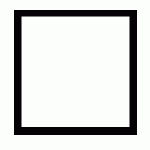 A square shape is symbolic of the “four corners” of the earth, the physical world, the tangible, the rational, our body, our material experience and the absolute of truth. It represents that which is defined and the finite..
A square shape is symbolic of the “four corners” of the earth, the physical world, the tangible, the rational, our body, our material experience and the absolute of truth. It represents that which is defined and the finite..
…
.
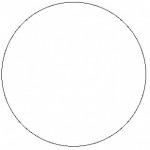 A circle shape is symbolic of the heavens, the spiritual world, the intangible, the irrational or transcendental, that which surrounds and embraces our spirit and ideal potential. It represents that which is beyond definition, the eternal and infinite..
A circle shape is symbolic of the heavens, the spiritual world, the intangible, the irrational or transcendental, that which surrounds and embraces our spirit and ideal potential. It represents that which is beyond definition, the eternal and infinite..
…
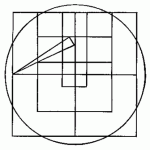 Squaring the Circle asks the initiate to reconcile the circle with the square, and through that process grow and receive wisdom. Can you reconcile the mind and the heart? Can you combine heaven and earth to find a place where they meet? Can you balance perfectly your intellect with your emotions to find a solution? How does your spirit and body combine to become one? Where is the boundary between justice and mercy? These are the questions answered through pondering and meditating on solutions to the puzzle.
Squaring the Circle asks the initiate to reconcile the circle with the square, and through that process grow and receive wisdom. Can you reconcile the mind and the heart? Can you combine heaven and earth to find a place where they meet? Can you balance perfectly your intellect with your emotions to find a solution? How does your spirit and body combine to become one? Where is the boundary between justice and mercy? These are the questions answered through pondering and meditating on solutions to the puzzle.
It is said that all truth (a square) can be circumscribed (a circle) into one great whole (perfection and enlightenment).
 The answers to Squaring the Circle will get you past the stumbling blocks, like gate keepers inside your soul, that prevent you from entering through the veil of mortality to your kingdom as a returning champion, a queen or king, the victorious hero from an epic quest.
The answers to Squaring the Circle will get you past the stumbling blocks, like gate keepers inside your soul, that prevent you from entering through the veil of mortality to your kingdom as a returning champion, a queen or king, the victorious hero from an epic quest.
Our contemporary modern society has moved away from metaphorical expression like this. We are often not comfortable working in symbol when it comes to the spiritual. If things aren’t factually true (such as the details of a myth), then they are false and should be discarded. We find artistic and religious metaphor silly, even pointless in our materialistic, technician-oriented culture. Left-brained labels and icons define all by putting things into neat boxes but leave out what the right brain intuits through relationship and proportion. If only there was a way to preserve this exercise of Squaring the Circle in a new religious framework, a way to re-purpose it for the modern world, many could benefit from such a metaphorical hero’s quest in their life journey. Someone would probably want to borrow from the ancients and from traditions handed down over the ages, since those that came before us already did so much work. It would be wasteful to reinvent the wheel completely from scratch, I would think. *wink*
-Brian Johnston, www.staylds.com


Comments 34
What a fascinating post.
Thank you. This has genuinely made new connections in my mind about how I can approach my spiritual life. Is there any good books (that discuss the history and symbolism of this problem) that you could recommend on this issue.
1.772453850905516027298167483314
I don’t get it, I guess I’m using the left side of my brain too much. I will try to square the circle, but it feels like an up hill battle to me.
Author
Some good books related to this subject:
“Sacred Geometry: Philosophy and Practice (Art and Imagination)” by Robert Lawlor
[Lawlor’s book has my favorite solution in it. This is a philosophical workbook.]
“A Beginner’s Guide to Constructing the Universe: Mathematical Archetypes of Nature, Art, and Science” by Michael S. Schneider
[A great book exploring numbers, geometry and philosophical/religious symbolism.]
“The Power of Myth” by Joseph Campbell
[A must read for anyone trying to tackle the importance of religious mythology, why it is so important for individuals and cultures.]
For starters I’d like to extend a bit of gratitude for shining some light this. I was wondering, in terms of years, do you have any idea as to how old the pricipals associated with the craft are?
If by “the craft” you mean Freemasonry, I believe that dates back to the 17th and 18th centuries. The symbols and concepts are found as far back as ancient Egypt though, if not ealier.
Are you implying Joseph borrowed such concepts for our church? Or are you suggesting that as such concepts were already borrowed into Masonry, they were also derivatively pushed into our theology. It is an interesting idea, but I think you need to connect the dots more.
Author
I am implying that these ideas have been around as long as we have human records. That makes them profoundly important. Many different groups have “borrowed” and used this line of thought. Masons have these elements in their practice. Joseph Smith was interested in a wide variety of sources that may have influenced his creative thought (and one can just as easily say divine inspiration depending on your view). I would not say that the body of LDS temple ceremony is “just” a copy of something else. It is not. I am saying that many traditions point to a common, transcendent idea. Every group looks up and sees the sun in the daytime sky. They all come up with a story for what it is. Some may borrow a little from each other, but that does not diminish the truth of a sun in the sky.
Each new tradition that points to these “truths” builds again a new experience appropriate and meaningful in the context of its time.
I think it is an interesting idea. I think the masonry connection is more likely rather than that he borrowed from other mathematical sources. However, I think that there is a certain way of thinking that is important here.
Thanks for the references. When you say Lawlor has your favourite solution are you implying that he solved it, I had recently read that it was impossible (but this was on wikipedia).
I will look up the books. Thanks.
OK I realise that my first attempt of squaring the circle mealy square rooted it, after looking in to squaring the circle further, it became apparent that it is impossible to complete the puzzle, the reason being that PI is transcendental meaning that the sequence of numbers is irrational, what I gained from this thought experiment is that not all things are rational, most of humanity seeks to rationalise and quantify the world which is why a concept such as squaring the circle even came about.
the point is not everything can be reduced to rational, symbolism does not have to make logical sense. [this is the result of MrQandA’s thought experiment, others may experience different results]
This is a fascinating concept, Brian. There are so many symbols in our worship that are out of reach to us at this point. I am reminded of the episode of Star Trek (original series) in which the tribe of people are worshiping the “sacred words,” but none of them understand that they are actually reciting the constitution of the United States, and they also don’t understand that their actions contradict the meaning of their “sacred words” because they lost the knowledge of what the words were. I’m sure as a fellow Trekker you’ll remember this epi.
Great concept…I’m starting to focus on solving this…wait…I think I…wait…
my head exploded.
Brian: I guess the information you seem to have but which seems unavailable here is how “squaring the circle” directly connects historically to masonry.
Pi is exactly 3! (1 Kings 7:23.)
Author
#7 Robert Lawlor doesn’t actually solve the problem in the precise mathematical sense. Like you mentioned, it is impossible. That in itself has meaning, and is a way to expand the mind and see something in our environment that is infinite — like the relationships of Phi or Pi. Robert Lawlor goes through an exercise in his book that approximates an answer through a serious of geometry steps. Each step has interesting philosophical meaning and symbolism. Several years ago, I used to enjoy working through his “solution” on paper as a form of meditation.
#8 Great example! Thanks for sharing that. What you are describing is the type of exercise I am talking about. As you ponder the question, the puzzle, it stretches your thoughts and gives you insights like that.
#11 I am not a mason, so I can’t speak authoritatively on their connections. I’ve read a couple books on their history though. As far as I know, they don’t really know their exact origin beyond a breakdown in their historical records in the early 1700’s. They have a mythology of origin going back to Solomon’s Temple, but most masons (as far as I know) don’t believe in that literal and historical connection. It is a metaphor to them also. In any case, they are one of many inheritors of a body of European esoteric wisdom from the middle ages.
I believe personally that Joseph was influenced by his exposure to masonry in addition to a short period of study in the Kabbalah. His early years were heavily influenced by European books on ritual and ceremonial magic (see D. Michael Quinn’s “Early Mormonism and the Magic World View”). The latter was a natural and normal part of his cultural environment. All of these sources approach this topic in various ways.
Being inspired by these sources can also be seen as divine inspiration. “Prophets” are a reaction to a spiritual, communal need in their environment. Prophets have no meaning without a context. I don’t like to overly simplify and dismiss Joseph Smith’s work by saying it is merely a copy of something else. That reduces the richness of all the sources.
Brian,
Not only is your post refreshing, but I am particularly pleased by your example at #6 about the sun. Symbols, like parables, are not intrinsically sacred, but the meaning one gives them can be…to that person. The hand can be a powerful symbol related to the priesthood, or it can be the tool of domestic violence of a drunk husband. Therefore, as long as they can put stimulate our deep meditating apparatus, it doesn’t matter where Joseph ‘got the stuff.’ He surely used it well.
Before temple teaching was modified and shrank to its actual format, there was a more elaborate discourse on symbolism, spirituality and righteousness. I don’t know if its removal from our temples is a positive thing, or more like God’s mark of disapproval for our lack of engagement with this material: ‘if of no value to us, heavens claw it back’ sort of thing.
Symbolism is not always a source of daily pondering, but stands as so many landmarks that structure our meditation. Temple and Cosmos by Nibley is interesting in highlighting the many times and places where these symbols were found and used as representations of metaphysical and/or religious truths.
Author
#14 I agree with you on feeling the instruction on symbolism is lacking, sadly removed. The current LDS Temple experience has its origin in the 1840’s Nauvoo period under Joseph Smith, and later formalized by Brigham Young. This was all in a period of time when many members of the Church were in fact also active masons, and they were more familiar with this type of ceremonial experience. We’ve lost a lot of that cultural context, or distanced our selves over the past 160 years from that way of thinking.
That makes, easily, 100 times more sense to me than previous explanations of these symbols. Thank you.
How does a trapazoid fit in all of this?
“If only there was a way to preserve this exercise of Squaring the Circle in a new religious framework, a way to re-purpose it for the modern world, many could benefit from such a metaphorical hero’s quest in their life journey.”
A TV producer once said (paraphrasing), “When considering what to air, you can never go wrong by *underestimating* the intelligence of the public.”
I cannot speak with any authority about how the “man in the street” — Mormon or anyone else, thought in the early 1800s, but I would conjecture that a great many Mormons that I have been acquainted with over the years is one that typifies the mind-set that it is quite content to just suckle on ‘milk’ rather than concern itself with any ‘meat.’ In other words, “I don’t want to think too much; I just want to ‘feel good’ when I go to church socializing with friends while preforming my calling(s) and stopping for desert after temple night, and things like that.”
If you ever attempt to broach a topic at church like Squaring the Circle or Joseph Smith’s “Grand Fundamental Principles.” etc, you just get blank stares, and even setting yourself up for future social avoidance. That’s the reality of what the church membership more and more like today. It goes along quite well with what President Hinkley said, “You can think anything you want, just keep it to yourself (again, paraphrasing).”
The modern Mormon hierarchy is extremely disinclined to promote and encourage anything that would attempt to “”re-purpose” anything that would suggest “a new religious framework.” And the general membership doesn’t want that either. It’s becoming more and more ‘The Church of the Religious Lumpen Proletariat.”
A challenge to my intellect is often exhilarating. I experienced this today, when I tackled some computer code that I needed to change and straighten out in some places. It’s hard sometimes to see where the error comes from, and you have to “execute” the code in your head to see where it breaks…
you seem to like problems help me with this new old one….
In 1937 the state of Montana conducted its first archeological dig “The Hagen Site”. Established as a National Historical Landmark in 1964 (it is presently undeveloped, and for sale).
The site is unusual due to the pottery and structure excavated at the site. The pottery is extremely advanced with a style that is hard to account for. The structure was built as a stationary building.
The equation; the lodge has a 16 foot diameter with 12 supporting posts. The front door faces to the sun raise with two posts 6 feet apart, the center has two posts 4 feet apart, the west wall has two post 2 feet apart. Being that the lodge is round, a sacred native symbol; I circled the other two points, the inner and outer circles.
Now you have your equation; A to B to C, gives you a 15 degree angle (1/24 of 360) .
The three proportional circles are now called out, and all 3 fit with-in the equation.
Hope you can enjoy this as much as I have.
hopimigration.com
Rod
see web site for pictures “Hagen Site”
Author
I pictured in my mind how that lodge experience must have looked, with the sun coming in through the opening. It must have been magical. What a beautiful concept, both simple and complex.
The square goes inside the circle.
except for the areas… that.. don’t fit.
This was a wonderful discovery (this article). Thank you for the time and effort used in putting this together. It helped me tremendously! Many Blessings!
You do know that it is impossible to Square a Circle, don’t you?
why is it impossible to square a circle?
once when meditating i could see a black circle with a white square above but with the bottom line missing like a goal post there was space between and a grey background i now have new insight into my exsperience thankyou
Wow this was the most history that I have ever learned in my entire life, and
I’m 93 years old! Glad you could post this and share it with me and with all of the other Egyptions in Houston, whyoming. Or wait, is it north Dakota? Idk I’m loosing my brains. Well see ya gal!
I appologize at start if my english is not perfect – it is not my native language, so I express myself on english not as I want, but as I can. I will try to express my opinion on the best possible way. It is a true that our science becomes materialistic and I studied electrical engineering on that way, never thinking about spiritual way of what I learned untill one day, when I figured out something about the numbers and I find the open book in front of myself that never ends.
Squering the circle means to know how to generate number pi, how to generate its next digit, and not only that. Squering the circle means also to be able to measure how long some curve line is. To measure curve line – it means you have to compare it with some streight line, but it is hard to fit them, isn’t it?
So, squering the circle is the same as comparing curve line and streight line and finding their corelation… as comparing soul and body and find the corelation… as comparing man and woman and find the corelation…as comparering good and evel and find the corelation.
Please watch the numbers – 012345678910 – but only as a forms.curve- 0, streight line – 1, combination – 2, only curves – 3, only streight lines – 4, combination – 5, combination – 6, streight lines – 7, curves – 8, combination – 9, streight line -1, curve – 0.Some of them are extremes (only curve or only streight lines) some of them are balance (combination). Each number has its own pair 01, 25, 34, 69, 78, 10 complicated as much as it is, but on some way opposite.
Now place them in the number pi…as you go more and more discovering number pi as a multiform you actualy know more about each its digit, about extremes and about balance.
As long you go from digit to digit of the number pi you will find out – at start was circle, at the end is circle – conection between these two is long, narrow and unsecure path very few people are following on the right way these days, holding faith in their souls as a small light of the candel.
Re: “If only there was a way to preserve this exercise of Squaring the Circle in a new religious framework, a way to re-purpose it for the modern world”
Consider the geometry of these recent “Pi Corral” designs which display the unique scalene triangle that squares the circle: http://www.aitnaru.org/images/Pi_Corral.pdf
The intrigue of this new perspective of Pi is that the perfect scalene triangle does exist somewhere in the transition from the smallest square of a circle to the largest square. When discovered, the bottom horizontal line of the scalene reflects the square root of Pi … regardless of the number of decimal digits!
The “Impossible Square method” (I-Square method) is a recent online contribution to this Greek challenge … and clearly shows a direct trigonometric relationship between Pi (half its square root) and the circle.
It is impossible to find a square of equal area to the area of a circle. You will be dealing with complex numbers and it then becomes impossible.